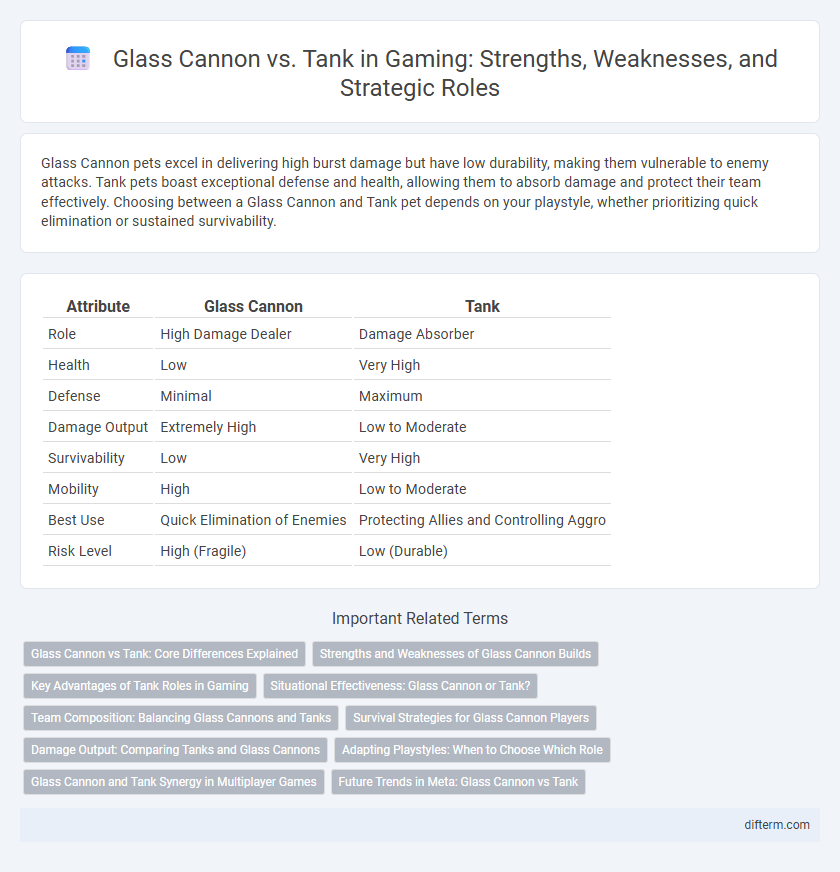Glass Cannon pets excel in delivering high burst damage but have low durability, making them vulnerable to enemy attacks. Tank pets boast exceptional defense and health, allowing them to absorb damage and protect their team effectively. Choosing between a Glass Cannon and Tank pet depends on your playstyle, whether prioritizing quick elimination or sustained survivability.
Table of Comparison
| Attribute | Glass Cannon | Tank |
|---|---|---|
| Role | High Damage Dealer | Damage Absorber |
| Health | Low | Very High |
| Defense | Minimal | Maximum |
| Damage Output | Extremely High | Low to Moderate |
| Survivability | Low | Very High |
| Mobility | High | Low to Moderate |
| Best Use | Quick Elimination of Enemies | Protecting Allies and Controlling Aggro |
| Risk Level | High (Fragile) | Low (Durable) |
Glass Cannon vs Tank: Core Differences Explained
Glass Cannon characters in gaming prioritize high damage output with minimal defense, making them powerful but vulnerable to attacks. Tank characters excel in durability and crowd control, absorbing damage to protect teammates while dealing moderate damage. The core difference lies in their roles: Glass Cannons focus on dealing massive burst damage quickly, whereas Tanks sustain prolonged fights by soaking damage and disrupting enemies.
Strengths and Weaknesses of Glass Cannon Builds
Glass Cannon builds excel in delivering high burst damage and quickly eliminating key targets, making them ideal for offensive playstyles in gaming. Their major weakness lies in low survivability and poor defense, which makes players highly vulnerable to crowd control and burst damage from opponents. Effective positioning and team support are essential to maximize the strengths of Glass Cannon builds while minimizing their exposure to risk.
Key Advantages of Tank Roles in Gaming
Tank roles in gaming excel at absorbing high damage and protecting teammates, providing crucial frontline defense that enables allies to deal damage safely. Their high health pools and crowd control abilities disrupt enemy formations, mitigating threats and controlling the battlefield effectively. Tanks often initiate team fights, creating opportunities for strategic plays and ensuring team survival during intense engagements.
Situational Effectiveness: Glass Cannon or Tank?
Glass cannons excel in situations requiring high burst damage and quick eliminations, thriving in team compositions that provide protection or crowd control. Tanks are more effective in frontline engagements and prolonged fights, absorbing damage and creating space for teammates to operate safely. Choosing between glass cannon and tank depends on the specific game scenario, team strategy, and opponent composition to maximize situational effectiveness.
Team Composition: Balancing Glass Cannons and Tanks
Effective team composition in gaming requires balancing glass cannons, known for their high damage output but low durability, with tanks who absorb damage and protect teammates. Integrating one or two glass cannons alongside reliable tanks ensures sustained damage while maintaining frontline defense. Optimal synergy between these roles enhances overall team survivability and combat effectiveness in competitive gameplay.
Survival Strategies for Glass Cannon Players
Glass cannon players maximize damage output at the expense of defense, requiring precise positioning and awareness to survive. Effective survival strategies include utilizing hit-and-run tactics, relying on crowd control abilities to keep enemies at bay, and prioritizing items or buffs that enhance evasion or movement speed. Mastering map awareness and cooldown management ensures glass cannons can unleash high damage bursts while minimizing exposure to incoming attacks.
Damage Output: Comparing Tanks and Glass Cannons
Glass Cannons deliver high damage output with their powerful but fragile attacks, excelling in bursting down enemies quickly but lacking survivability. Tanks trade raw damage for durability, absorbing significant amounts of damage to protect allies and sustain longer in fights, often relying on crowd control and defensive abilities. Understanding the balance between burst damage and survivability is crucial for team composition and strategy in competitive gaming scenarios.
Adapting Playstyles: When to Choose Which Role
Choosing between a Glass Cannon and a Tank depends on team composition and match objectives, where Glass Cannons excel in high damage output but remain vulnerable, while Tanks absorb damage and control engagements. In aggressive strategies, a Glass Cannon's burst damage can secure quick kills, but in defensive or prolonged fights, Tanks provide essential durability and crowd control. Adapting playstyle requires evaluating enemy threats and allied support to maximize each role's effectiveness within varied in-game scenarios.
Glass Cannon and Tank Synergy in Multiplayer Games
Glass Cannon and Tank synergy in multiplayer games creates a balanced team dynamic by combining high damage output with strong durability. Tanks absorb enemy aggression and control the battlefield, allowing Glass Cannons to unleash powerful attacks without being easily targeted. This synergy enhances team survivability and damage potential, making coordinated strategies crucial for dominating matches.
Future Trends in Meta: Glass Cannon vs Tank
Future trends in the gaming meta indicate a shift toward hybrid builds that combine the high burst damage of Glass Cannons with the survivability features of Tanks, optimizing both offense and defense. Game developers are increasingly designing skills and gear that allow for flexible playstyles, enabling characters to adapt dynamically to changing battle conditions. Data from recent esports tournaments show a rising preference for adaptable heroes capable of switching roles mid-game, reflecting evolving player strategies and meta demands.
Glass Cannon vs Tank Infographic

 difterm.com
difterm.com